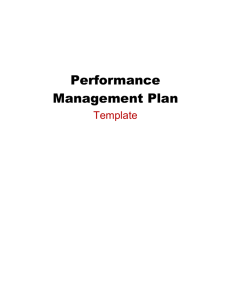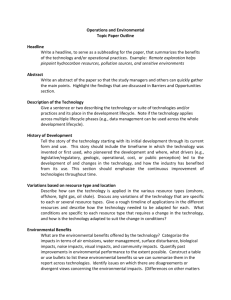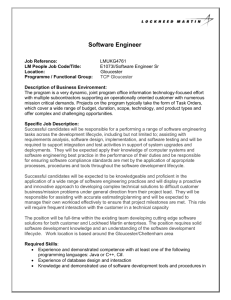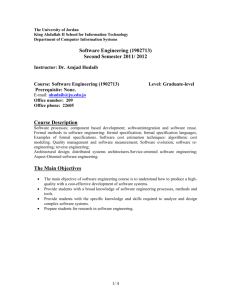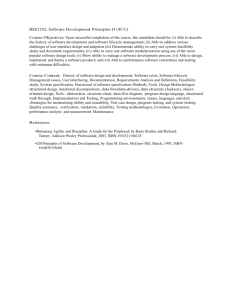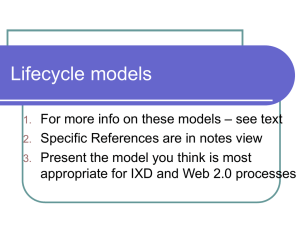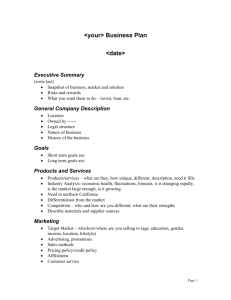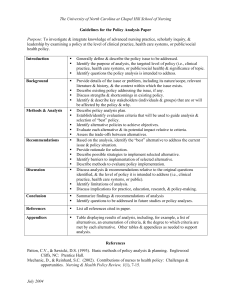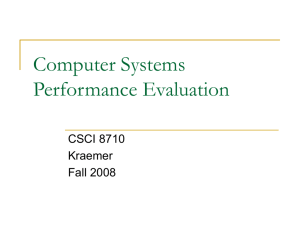template instructions
advertisement
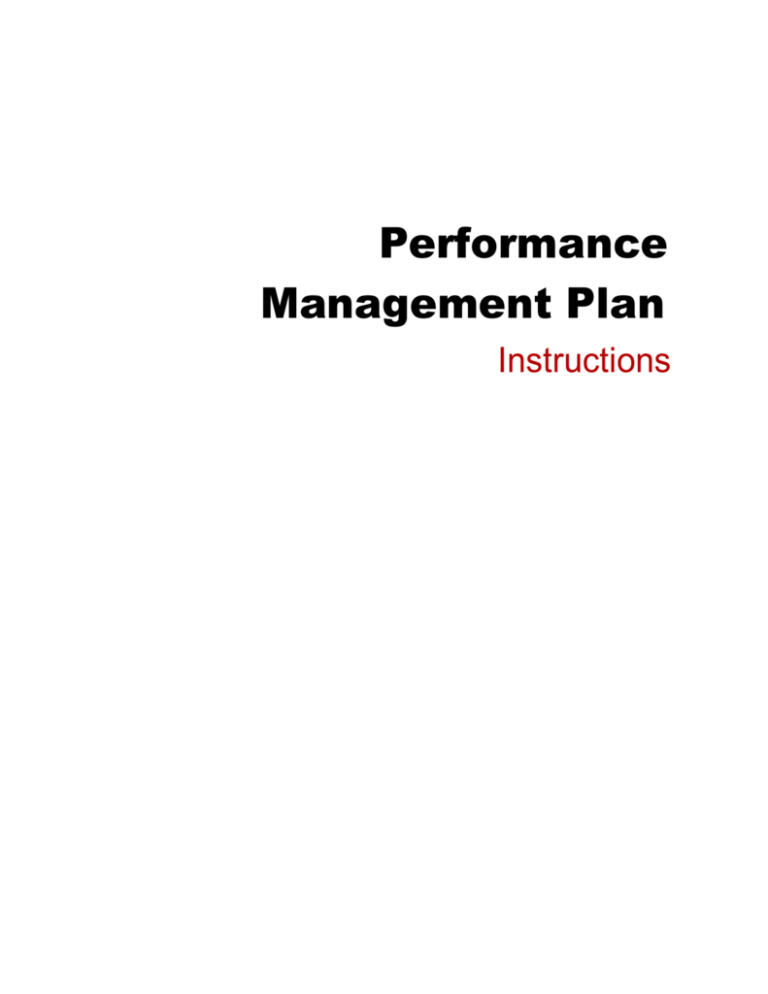
Performance Management Plan Instructions Lifecycle Performance Professionals PERFORMANCE MANAGEMENT PLAN INSTRUCTIONS Contents Introduction ... .......................................................................................................... ...1 Use of the Performance Management Plan ... ........................................................ ..1 Overview ... ...................................................................................................... .1 Applicability ... ................................................................................................ ...1 Governance and Scope ... ............................................................................. ..2 Section 1. Performance Management Approach ... ................................................ .2 1.1 Performance Scope ... ............................................................................ .2 1.2 Roles Definition ... .................................................................................. ..2 1.3 Performance Objectives.......................................................................... .2 1.4 Performance Standards and Measurements ... .................................... ..3 Section 2. Performance Tracking... .......................................................................... .3 2.1 Data Collection and Reporting ... .......................................................... ...3 2.2 Monitoring and Evaluation ... ................................................................ ...3 2.3 Tools and Techniques............................................................................. .4 Section 3. Glossary .................................................................................................. .4 Section 4. Revision History ... .................................................................................. .4 Section 5. Appendices ... ......................................................................................... ..4 Appendix. Performance Project Areas, Categories, and Measures ... .................. ..5 Page i Lifecycle Performance Professionals PERFORMANCE MANAGEMENT PLAN INSTRUCTIONS Introduction Many Information Technology (IT) projects are delivered on-time and on-budget, but fail to meet performance requirements. IT products and services are being delivered that are unable to achieve the performance expectations identified during project planning. A high-quality product or service that meets performance requirements and is delivered on-time and on-budget is the true measure of success. A key component of meeting performance requirements is the ability to measure, which is the cornerstone of performance management. The Performance Management Plan is included within the Texas Project Delivery Framework (Framework) to establish a consistent method for definition of activities and resources needed to manage product and/or service performance. Performance management involves assessment, measurement, monitoring, and reporting of the expected product and/or service performance outcomes established for a project. This Performance Management Plan establishes standards for measuring how the product and/or service performance objectives support the business goals of the organization and the project. Performance standards are used to measure the overall effectiveness of performance in areas such as quality, productivity, and response, regardless of whether a type of service is involved. Service standards are used to measure the overall effectiveness of the vendor performance in terms of services provided. Use of the Performance Management Plan Overview Within the Framework, the Performance Management Plan is a key deliverable of the Project Planning review gate. Review the Project Plan Instructions for information about the Performance Management Plan in relation to the Project Plan. Agencies should review and use the business goals and objectives identified in the Business Case and refined in the Project Charter as the basis for measuring the product and/or service performance. Throughout the project life cycle and product or service useful life, performance reviews and evaluations of the project outcomes should be conducted based on the plans described in the Performance Management Plan. Agencies may choose to use the Framework supplemental tool provided as an appendix within the Performance Management Plan Instructions. This tool is intended to assist a project team in establishing performance measurements for different areas of a project. Applicability A Performance Management Plan must be developed for any project classified as a major information resources project. Page 1 Lifecycle Performance Professionals PERFORMANCE MANAGEMENT PLAN INSTRUCTIONS Governance and Scope The Project Manager has ultimate responsibility for ensuring the Performance Management Plan is developed in conjunction with the Project Plan. A key responsibility of the Project Manager is to ensure the Performance Management Plan is integrated into the overall planning as outlined by the Project Plan. Section 1. Performance Management Approach The Performance Management Strategy section describes and outlines the approach for managing the product and/or service performance. The strategy involves identifying boundaries that impact performance measurement results, performance objectives, and performance standards and associated measurements for determining whether the performance objectives were satisfied. 1.1 Performance Scope Describe the scope of the performance management effort in relation to the project. The performance scope defines limits in terms of managing the performance of the goods and/or services. Although the project may deliver the goods and/or services, other products and/or services (outside of the scope of the project) may impact performance outcomes. In some cases, products and/or services delivered by the project may be excluded from the scope of this Performance Management Plan and addressed external to the project. 1.2 Roles Definition Complete the performance management activity matrix for each of the project roles and/or functional areas. A critical, and often overlooked planning step for IT projects, is joint definition of how the various roles will work together to manage the performance of the product and/or service over the life of the project. Performance management includes activities such as collection of data required to report the product and/or service performance. Review of the collected data is also defined as part of the activities. Other performance management activities should be defined. The project team should clearly define who (e.g., Business Manager, Project Manager, vendor) is responsible for each of the performance management activities considered essential for project success. Activities should be included with consideration for the entire performance management scope. When complete, the matrix should reflect by functional role the assigned responsibility for key performance management activities. 1.3 Performance Objectives Identify each project business objectives that is directly related to the product or service being delivered by the project. The project business goals and objectives identified in the Business Case and refined in the Project Charter provide the basis for identifying the performance objectives. Identify product and/or service performance objectives that relate to the business goals and objectives established for the project. Page 2 Lifecycle Performance Professionals PERFORMANCE MANAGEMENT PLAN INSTRUCTIONS 1.4 Performance Standards and Measurements Identify performance standards and measurements for each of the performance objectives. Include standards and associated measurements for both the product and/or service as needed. Performance standards are used to measure the overall effectiveness of performance in areas such as quality, productivity, and response, regardless of whether a type of service is involved. A performance standard example is 99% overall system availability and an example measurement for that standard is total minutes of system down-time on a daily, weekly, and monthly basis. Performance standards include service standards but not every performance standard is a service standard. For example, the installation of hardware as a contract deliverable does not impact services; however, using the installed hardware to provide a service may impact a service standard. Service standards are used to measure the overall effectiveness of the vendor performance in terms of services provided. A service standard example is 80% of customer problem calls answered within 20 seconds and an example measurement for that standard is number of calls answered within how many seconds. Service standards are a subset of performance standards. The performance standards may be sub-divided into performance categories based on project needs. Add another column to indicate and identify performance standards categories if needed. A generic classification of IT project issue areas with their associated measurement categories and measures is provided as a Framework supplemental tool in the Appendices. Section 2. Performance Tracking The Performance Tracking section describes activities and methods for tracking the performance of the product and/or services. Methods for collecting the measurement data and responsibilities involved in the performance management effort are included. 2.1 Data Collection and Reporting Describe how performance measurement data will be collected, reviewed, and reported. For each performance measurement identify the: • Collection method, including use of baseline values, source of the data, etc. • Collection schedule • Review method, including management and/or project team analysis • Who has responsibility for the collection and/or review methods • Reports 2.2 Monitoring and Evaluation Identify the various approaches for ensuring performance management activities are being executed as described in this Performance Management Plan and that performance outcomes Page 3 Lifecycle Performance Professionals PERFORMANCE MANAGEMENT PLAN INSTRUCTIONS are being evaluated. List and provide scheduled dates and/or frequency for each of the planned events and/or activities. 2.3 Tools and Techniques Specify the tools and techniques required to execute performance management tracking. Tools can be performance management-specific, standard organizational resources, and/or specifically acquired or developed for this project. Describe any techniques needed for managing the performance of the product and/or service. Section 3. Glossary Define all terms and acronyms required to interpret the Performance Management Plan properly. Section 4. Revision History Identify changes to the Performance Management Plan. Section 5. Appendices Include any relevant appendices. Page 4
